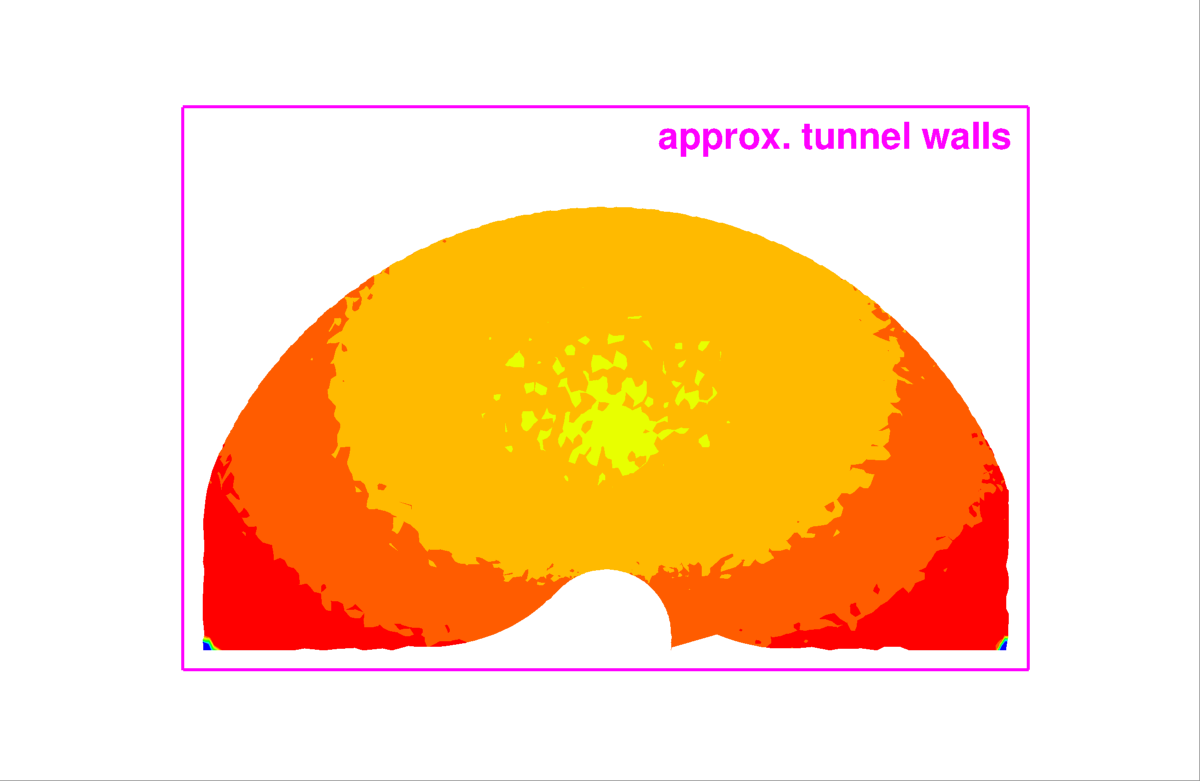 |
Langley Research CenterTurbulence Modeling Resource |
Exp: NASA Juncture Flow (JF) - Turbulent F6-Based Boundary Conditions
Return to: Exp: NASA Juncture Flow - Intro Page for Turbulent F6-Based Wing
Return to: Exp: NASA Juncture Flow - Intro Page Return to: Data from Experiments - Intro Page Return to: Turbulence Modeling Resource Home Page
This page provides information from the Juncture Flow test
to help users determine appropriate boundary conditions for CFD runs.
The most important information for running CFD is listed under "GENERAL" below.
Some of the other data are not strictly boundary conditions, but
rather may be useful for checking aspects of the CFD methodology.
For example, data were collected on the model itself well upstream of the separated region of
interest, with the intent that these data could serve as references for CFD comparisons
(see MODEL NOSE REGION section below).
The following limited information about wind tunnel inflow characterization is provided:
turbulence level, wall boundary layer thickness, and "other" (total pressure and flow angularity).
Note that collecting inflow conditions is particularly difficult during a model entry in a major
wind tunnel like the 14x22, so some of this was
done in separate tests; analysis of much of it is still ongoing.
The effects of including realistic nonuniform inflow conditions in a CFD in-tunnel
run are not yet known on the quantities of interest for this case.
GENERAL
As described on the
Exp: NASA Juncture Flow - Intro Page for Turbulent F6-Based Wing,
the nominal conditions for the Juncture Flow test were:
Description of the model tripping can be found in
NASA/TM-2019-220286
as well as in the notes on the
Exp: NASA Juncture Flow - Turbulent F6-Based Geometry) page.
It is important to note
that the inboard-most portion of the wing (extending
roughly 25 mm away from the fuselage)
is located within the fuselage's turbulent boundary layer. Further outboard, however,
the boundary layer on the horn and wing leading edge is laminar up to the trip dots,
as evidenced by infrared images acquired on the upper wing surface during Test 653.
Additional details are provided in the following document:
Slides Describing T653 IR Results (gzipped pdf file).
The 14x22 wind tunnel is controlled by measuring total pressure, static pressure (actually delta p
between the total and the static), stagnation temperature,
and dewpoint at specific locations in the tunnel and applying calibration equations. Details can
be found in
NASA/TM-2014-218513,
NASA/TM-2018-219812,
and
NASA Technical Report 20190018049, 2019.
Strategies for Running Juncture Flow CFD in the Tunnel
(pdf file) summarizes important information regarding in-tunnel computations.
MODEL NOSE REGION
Extensive flowfield data in the model nose region (near x=1168 mm), well
upstream of the wing, are included in the LDV results provided on the
Exp: NASA Juncture Flow (JF) - Turbulent F6-Based Experimental Data page.
In addition, a single wall skin friction value was obtained for a model pitch angle
of 0 deg only, using a Preston tube:
TUNNEL INFLOW TURBULENCE LEVEL
Tunnel inflow turbulence was not measured during this test. However, it was measured previously,
as reported in
NASA/TP-2004-213247.
Using the results from that report, the presumed
freestream turbulence intensity for this test is approximately 0.07% - 0.08%.
Recall, however, that the model was tripped in the JF test.
TUNNEL WALL INCOMING BOUNDARY LAYER THICKNESS
Using wall rake data from this test, the 14x22 wall boundary layer thickness measured upstream of
the model (behind the start of the test section, away from the corners) was consistent on the
top and both side walls. These measures were also consistent with earlier unpublished
measurements of the boundary layer on the floor. Therefore, it can be assumed that the tunnel
wall boundary layers were roughly 4 - 5 inches (100 - 125 mm) thick at 5 - 6 feet (1.5 - 1.8 m)
behind the start of the test section for the JF test.
Slides Describing Tunnel Wall Rake Data (pdf file)
These data are consistent with previously-measured 14x22 wall boundary layer thickness
(14x22_Boundary_Layer_Summary.pdf.gz (gzipped)). Note
the previous measurements also included the effect of the Boundary Layer Removal
System (BLRS) on the bottom wall. The BLRS was not used in the JF test.
OTHER KNOWN TUNNEL INFLOW CHARACTERISTICS
Slides Describing Measured Inflow Characteristics (pdf file)
For additional 14x22 wind tunnel details, see
NASA TP 3008, September 1990 and
NASA TM 85662, December 1983.
TUNNEL SIDE AND TOP WALL PRESSURES
T653CpWallData_2022.tar.gz (0.2 MB)
<- updated 08/19/2022 (now accounts for total pressure deficit in 14x22 tunnel)
TUNNEL DIFFUSER BOTTOM WALL PRESSURES
DiffuserPressures_JF.tar.gz (4.0 MB)
Return to: Exp: NASA Juncture Flow - Intro Page for Turbulent F6-Based Wing
Recent significant updates: Responsible NASA Official:
Ethan Vogel
See notes on the
Exp: NASA Juncture Flow - Turbulent F6-Based Geometry) page
for discussions regarding angle-of-attack corrections, aeroelasticity, and model adherence to
as-designed shape. Strictly speaking, running a CFD model in tunnel should best represent
the experiment, but the effect on many quantities of interest (QoI) may be relatively minor.
See
AIAA-2019-0080,
AIAA-2020-1304, and
AIAA-2021-1428
for CFD results both in free air and in tunnel.)

08/19/2022 - posted update to tunnel side and top wall pressures
12/10/2020 - posted slides describing T653 IR results
10/15/2020 - posted tunnel side wall and top wall pressures
09/14/2020 - modified description of the state of the boundary layer upstream of trip dots on horn, based on IR taken in test 653
01/21/2020 - added discussion about tripping and likely attachment line contamination inboard
07/02/2019 - added "Strategies for Running Juncture Flow CFD in the Tunnel" document
07/01/2019 - added diffuser pressures
06/13/2019 - added slides describing tunnel wall rake data (pdf file)
05/31/2019 - added slides describing measured inflow characteristics (pdf file)
Page Curator:
Clark Pederson
Last Updated: 08/14/2025